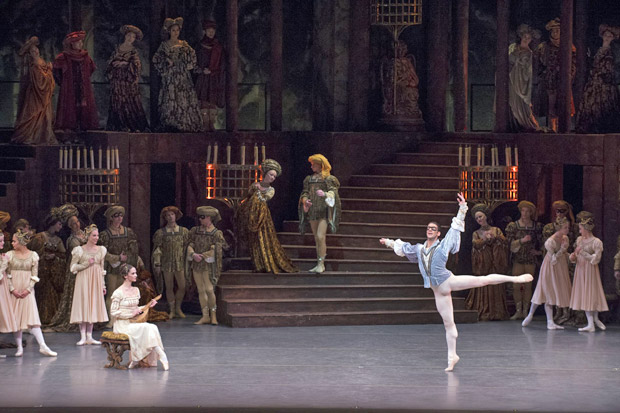
© and provided by HK Leisure & Cultural Services Department
(Click image for larger version)
American Ballet Theatre
Gala 1: Drink To Me Only With Thine Eyes / Black Swan pdd / Stars & Stripes pdd / Shostakovich Symphony #9
Gala 2: The Leaves Are Fading / The Moor’s Pavane / Symphony in C
Romeo and Juliet
Hong Kong, Cultural Centre, Grand Theatre
21, 22, 27, 28 February 2013
www.abt.org
www.hk.artsfestival.org
A version of this review previously appeared in the South China Morning Post
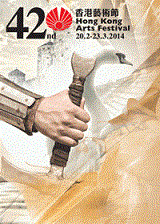 American Ballet Theatre returned to Hong Kong after an absence of 13 years to present three programmes in the Hong Kong Arts Festival, giving the chance to assess the company’s current crop of dancers in ballets largely drawn from its historic repertoire.
American Ballet Theatre returned to Hong Kong after an absence of 13 years to present three programmes in the Hong Kong Arts Festival, giving the chance to assess the company’s current crop of dancers in ballets largely drawn from its historic repertoire.
The season began with a high-energy mixed bill which showed the company on sparkling form.
Mark Morris’s 1988 Drink to Me Only With Thine Eyes made a charming, lighthearted opener. If it looks less innovative today than on its creation, the airy choreography is pleasing and its play on classical steps has a welcome subtlety. The young cast danced well, with Joseph Gorak making a strong impression (you don’t often see a male dancer with a 6 o’clock extension).
The most anticipated piece was Alexei Ratmansky’s Symphony #9. Created for the company only last October, this was a rare opportunity for Hong Kong to see a major new work danced by its original cast. The first in a planned suite of three new one-act ballets set to Shostakovich, it demonstrated yet again Ratmansky’s affinity for the composer’s music and made an interesting comparison with his glittering Concerto DHSC, seen here with New York City Ballet in 2011.
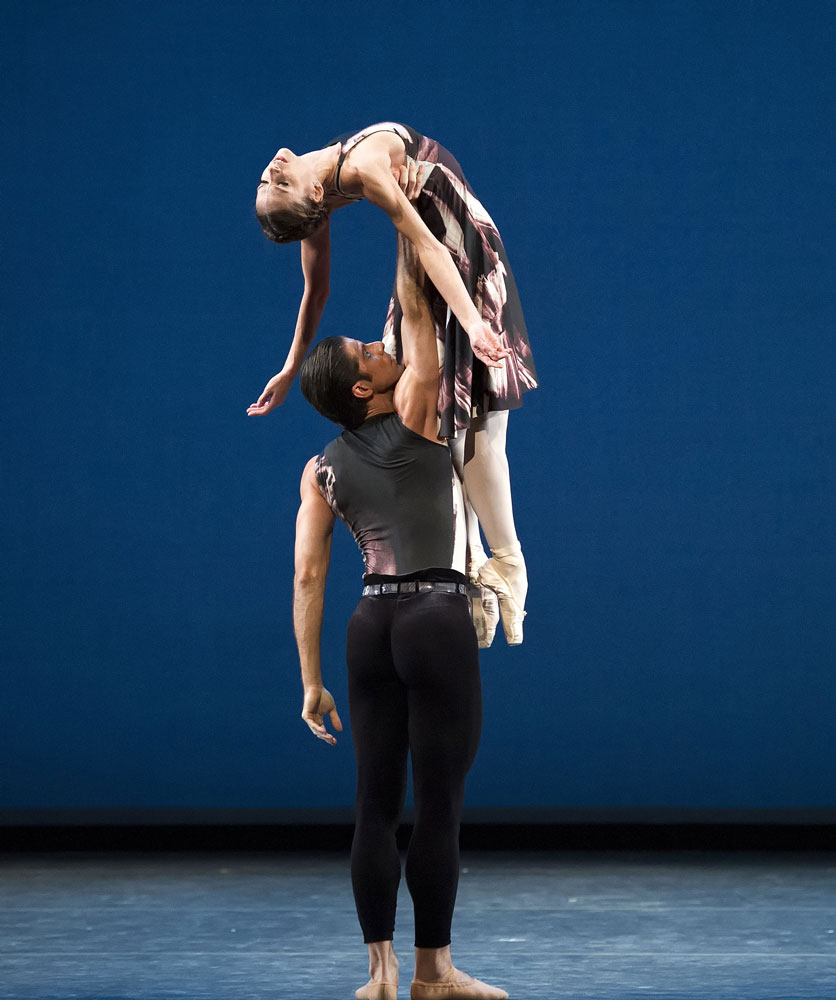
© Gene Schiavone. (Click image for larger version)
Symphony #9 presents a special challenge due to its abrupt transitions between lively, even brash, fast sequences and darker moods. On this first viewing I don’t feel Ratmansky quite overcomes the jarring quality of these contrasts. However, he deals magnificently with the often-frenetic pace and responds to the music with choreography which intriguingly combines ultra-rapid, complex footwork with lush, generous upper-body movement, showing how he has absorbed the influence of both the Danish school, where he spent the formative years of his professional career, and the Russian school, where he began. Above all, the steps flow and grow out of each other with that sense of utter rightness, of the natural inevitability of the next step which is the hallmark of a great choreographer. Less immediately accessible than Concerto DHSC, it remains to be seen what place the piece will ultimately occupy in Ratmansky’s oeuvre. Undoubtedly it needs (and deserves) to be seen more than once. It was superbly performed, with outstanding work from Herman Cornejo, Simone Messmer, Polina Semionova and Craig Salstein.
Fittingly from a company which has the status of America’s official national ballet, the high point of the evening was the pas de deux from George Balanchine’s exuberant Stars and Stripes set to military band music by John Philip Sousa (including, disconcertingly, The Liberty Bell, best known as the irresistibly rumty-tumty theme tune of Monty Python). As packed with pyrotechnics as the Fourth of July, it was performed with brilliance, bravura and a splendid sense of fun by Daniil Simkin, a young Russian-born dancer whose effortless virtuosity, immaculate finishing and sheer joy in dancing reminded me of the young Baryshnikov. After a slightly nervous start, his partner Sarah Lane worked up to a similarly dazzling finale and together they brought the house down with repeated curtain calls.

© Gene Schiavone. (Click image for larger version)
Alas, the fireworks failed to go off in the preceding Black Swan pas de deux – a lacklustre rendering by Paloma Herrera and Corey Stearns which was the only let-down in an otherwise excellent programme. Herrera faltered on a few steps, notably the fouettes and to put it bluntly, was simply not glamorous or seductive enough for Odile. Stearns had a good jump but lacked the virtuosity and elan needed in this context.
If the first mixed bill was high energy, the second was all too sedate. While it was natural for ABT to bring one of their Tudor ballets, The Leaves Are Fading was a disappointing choice. The choreography is well-made, musical and lyrical – unfortunately it is also excruciatingly dull. The audience was soon fading faster than the leaves, with several people spotted asleep in their seats. The music is largely to blame – an exercise in monotony, it is hardly surprising that this should be one of Dvorak’s “lesser-known” works. The ballet might have had more impact had the company’s most senior ballerina, Julie Kent, famed for her dramatic ability, been able to dance the lead as originally scheduled. With Kent out through injury her replacement, Hee Seo, danced well but lacked the force of personality to bring the piece to life. Only Polina Semionova and Alexander Hammoudi managed to invest their duet with enough authority to transcend the general insipidty and make a torpid audience take notice.
Next came another 20th century classic, José Limón’s 1949 The Moor’s Pavane. Although now somewhat dated (and somewhat of a curiosity at any time), the piece justifies its fame. Limón’s concept remains effective – the distillation of Othello into a 20 minute four-hander is brilliantly realised and if there is relatively little actual dancing, there is plenty of dramatic tension. All four dancers – Xiomara Reyes, Simone Messmer, Roman Zhurbin and especially Thomas Forster as Iago – were superb and the performance had every ounce of the emotional commitment and intensity the work demands.
Balanchine’s Symphony in C received a mixed performance from the soloists. Herrera in the first movement was on far better form than in the Black Swan, dancing with ease and assurance – I greatly admired the beauty of her arms – and her partner, James Whiteside, was notably light and elegant, with fine elevation. In the third movement Simkin shone again and Sarah Lane came into her own with a scintillating account of the fourth movement which was an ideal example of Balanchine style and technique. A real pity that Veronika Part in the second movement let the side down with one of the worst performances I have had the misfortune to see from a dancer at this level, messing up her main solo disastrously and compounding the problem with a general air of couldn’t care less.
The rest of the season was devoted to seven performances of MacMillan’s Romeo and Juliet which gave the opportunity to compare ABT’s version, staged for them by the choreographer in 1985 when he was Resident Artist, with his original Royal Ballet production.
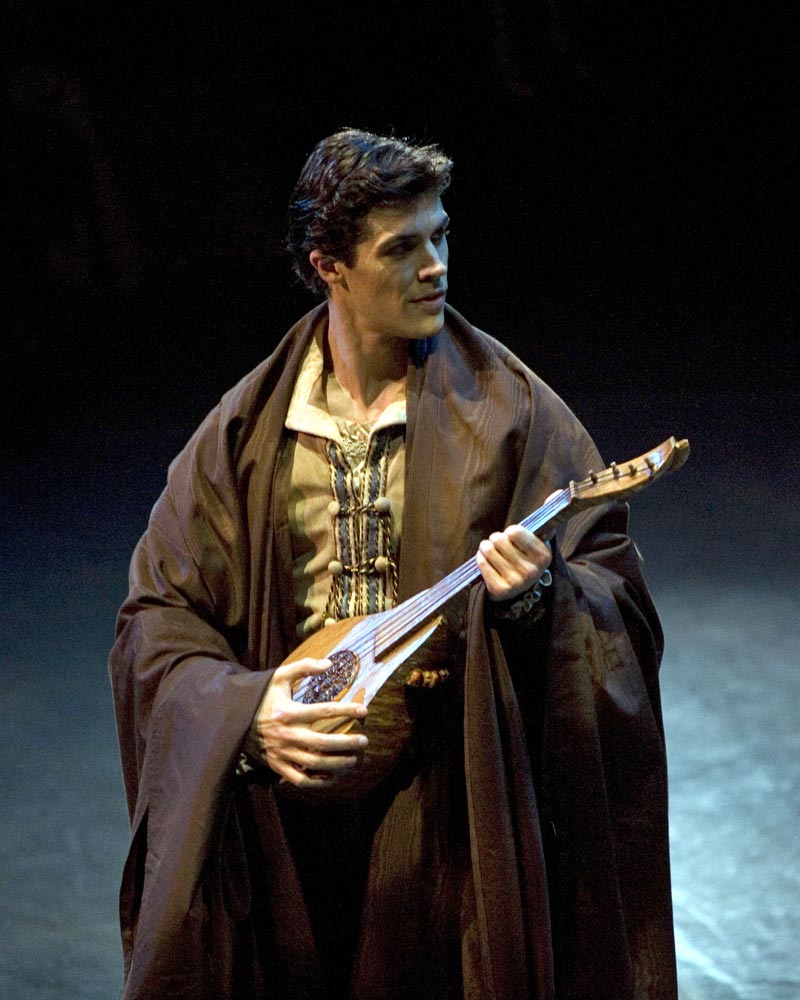
© Rosalie O’Connor. (Click image for larger version)
I will nail my colours to the mast and confess to finding the MacMillan version far and away the best out of the dozen or so I have seen. It strikes the best balance between the testosterone-driven street scenes and the love story, it has the most beautiful pas de deux and I never fail to be moved by the sheer musicality of the choreography.
The only major difference in the text I was able to spot was that the lead in the Mandolin Dance is given to Mercutio who performs it as a virtuoso divertissement. Enjoyable in terms of dancing though this may be, it’s a mistake dramatically to take Mercutio out of character just before his death –it doesn’t fit in such a realistic ballet.
It must be said that ABT cannot compete with the Royal Ballet’s tremendous strength in depth and experience in big narrative works of this kind. Whether due to differences in the production itself, individual interpretation or lack of rehearsal, some moments failed to make their usual impact, particularly the humourous ones. The first night performance didn’t come together in Act 1 and although it improved as it went on, the interplay of the supporting characters never really gelled. The next night was much tighter with the company looking more at home on the stage and with each other.
Ultimately, of course, the ballet stands or falls by Romeo and Juliet themselves. On the first night, Hee Seo made a gentle, touching Juliet. Her interpretation is intelligent while her dancing is distinguished by exquisite feet and the melting fluidity in lifts this role demands. Her Romeo was Roberto Bolle, whose magnificent partnering made the pas de deux so smooth it was hard to believe that Seo had stepped in at the last minute due to Julie Kent’s injury. Both gave fine performances, with a thrilling Balcony Scene pas de deux a stand-out.

© and provided by HK Leisure & Cultural Services Department
(Click image for larger version)
The second night saw an extraordinary performance from two great dancers at the height of their powers, Marcelo Gomes and Polina Semionova. One of those occasions in the theatre when the shiver goes down your spine and you know you are privileged to be there. Equally convincing in the pas de deux and the fight scenes, Gomes’ dancing had a speed, power and attack that was literally breathtaking, with spectacular jumps and turns, beautiful finishing and effortless partnering. His warm, charismatic stage presence completed one of the finest performances of the role I have seen – I don’t recall ever seeing the Balcony Scene solos quite so well danced. Semionova matched him with dazzling dancing and an interpretation of exceptional dramatic power and passion – her desperation when Romeo flees Verona and her defiance of her parents were devastating.
Things were more mixed among the supporting casts. While both Craig Salstein and Arron Scott pulled out the virtuoso stops as Mercutio in the Mandolin Dance, neither managed to convey that Mercutio is dangerous as well as amusing or to make the death scene moving enough; nor did they fully capture the style of the choreography in their trios with Romeo and Benvolio. Simkin’s perfectly musical Benvolio, however, showed exactly how the choreography should be danced. The Tybalt in both casts I saw was Sascha Radetsky, a good actor who opts for making the character surprisingly sympathetic – he kills Mercutio by accident, for instance, although this may be a feature of the ABT production rather than an individual choice. An interesting concept, this goes too much against the grain of both Shakespeare and Prokofiev to be totally successful.
As Paris, Alexandre Hammoudi was so good-looking you wondered why Juliet ever noticed Romeo while Daniel Mantei boldly made him thoroughly unpleasant, with a distinct suggestion that Juliet might have ended up as a battered wife had she married him. Stella Abrera was a striking Lady Capulet and Roman Zhurbin a powerful Lord Capulet.
Unfortunately the composer didn’t come off as well as the choreographer with the Hong Kong Sinfonietta inexplicably off-form after good performances in the previous programmes. To paraphrase Oscar Wilde, wrong notes in one performance may be regarded as a misfortune, wrong notes two performances running looks remarkably like carelessness.

© and provided by HK Leisure & Cultural Services Department
(Click image for larger version)
All in all, I enjoyed the ABT season very much. That this is a touring company which must struggle for funding does show at times, particularly where the corps is concerned – the dancers are hired on seasonal contracts which makes it harder to build a seamless ensemble the way that permanent troupes like the Royal Ballet or the Paris Opera are able to do. However, there was a major improvement compared to their previous visit to Hong Kong in 2000, notably in the female dancers’ port de bras (perhaps attributable to having the great Mariinsky ballerina Irina Kolpakova as one of their teachers).
The level of the soloists is generally high with a number of dancers I would like to see more of – Messmer, Hammoudi and Gorak amongst them. As for the principals, Semionova and Gomes are already international stars; Simkin and Lane deserve to be.












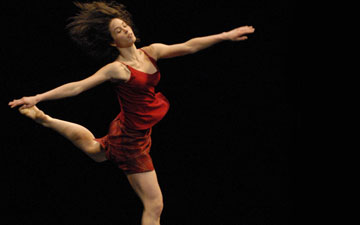

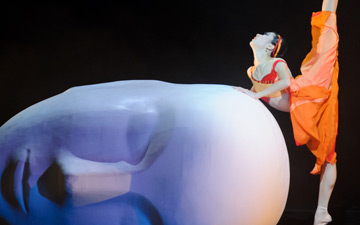
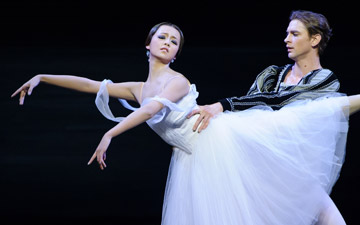
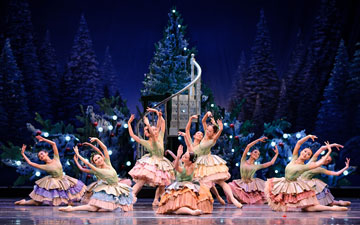
You must be logged in to post a comment.